By Ryan Schwab
Over the last two and a half years, our group has been visiting lawns of all kinds across the Twin Cities as part of the Twin Cities Metropolitan Area Long-Term Ecological Research project focused on urban nature. These assessments include identifying and recording plant species found throughout the lawn as part of the Effectiveness of Pollinator Habitat objective. In 2022, we observed 119 different plant species across 79 properties. Many of these species are commonly found in Minnesota, but not always in lawns. Some are frequently observed in other landscape types such as restored prairies, roadsides, wetlands, forest edges and floors, and agricultural fields. Plants migrate, and they may thrive in a handful of systems; however, thriving can be problematic. A species could be a suitable ground cover or pollinator resource in your lawn but displace native or naturalized plants in another landscape type. When this happens, the natural ecosystem can change drastically over time. Plants that behave this way are considered invasive.
The Minnesota Department of Natural Resources and Department of Agriculture maintains a list of invasive terrestrial plant species that are restricted or prohibited in the state. Many of these weeds have restrictions on seed sales, propagation, or introduction to inhibit their spread. Other species are considered invasive but are not regulated and rely on the public to voluntarily make decisions to inhibit spread to vulnerable areas. From a lawn care perspective, invasive species can often be difficult to eradicate, but preventing their ability to go to seed or spread into neighboring properties may be more manageable. Creeping Charlie (Glechoma hederacea), for example, can spread quickly and be difficult to control in a lawn. Instead of eradicating it fully, focusing on removing or slowing it down on the edges of the lawn may be a more efficient tactic using barriers, hand-pulling, or herbicides. For many invasive species, containment may be the only feasible option, regardless of landscape type.

Our team recorded a handful of invasive plant species during lawn assessments (Figure 1). Some of the homeowners we’ve chatted with expressed their willingness to let these plants give color and potential pollinator resources to their lawns without knowing they are on the invasive plant species list. Invasive species that we often observe blooming in lawns are briefly discussed below.
Creeping Charlie (Glechoma hederacea)
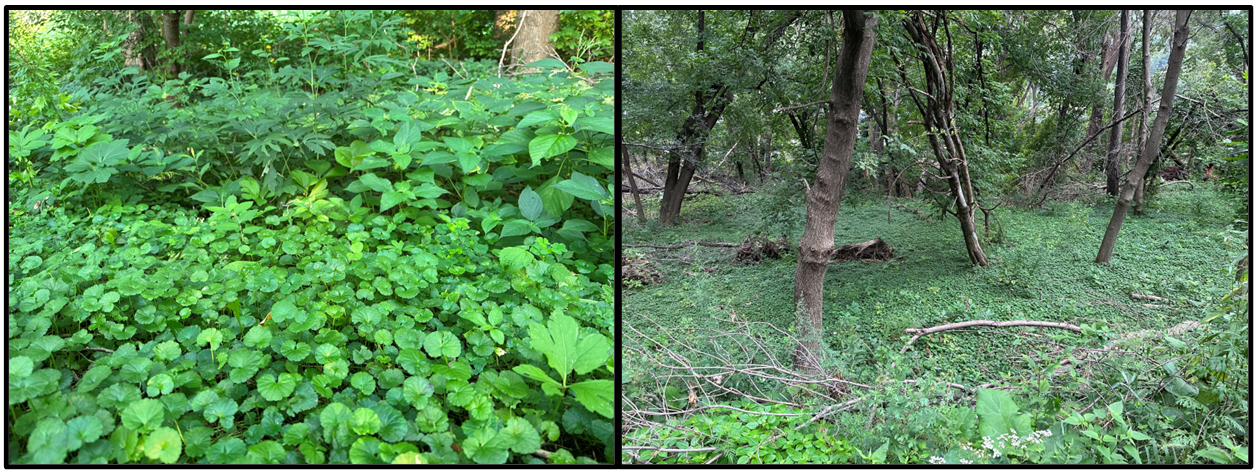
It was not surprising that creeping Charlie was the most abundant invasive plant species on our list. We receive plenty of questions regarding creeping Charlie control each year. This invasive species is not regulated, but can be an issue in gardens, lawns, and disturbed forest floors (Figure 2). Vegetative spread is aggressive with creeping stolons on the soil surface and leaves growing to the top of the foundational groundcover. Its purple flowers are present from spring to early summer. This early bloom may provide inconsistent benefits to active pollinators.
Creeping bellflower (Campanula rapunculoides)

Creeping bellflower basal leaves can look like creeping Charlie’s. Creeping bellflower’s leaves are less shiny and can be more heart-shaped and longer. Stalk leaves tend to be pointier and longer than those at the base (Figure 3). About as aggressive as creeping Charlie, creeping bellflower can be more difficult to hand-pull due to its rhizomatous spread. This species also spreads by seed. Similar to hostas (Hosta spp.), light purple flowers bloom from their upright stalk, which may be attractive to some homeowners. This is a non-regulated invasive species. Our group spots creeping bellflower frequently in gardens, along shaded edges or woods, and in both mown and unmown lawns.
Birdsfoot trefoil (Lotus corniculatus)
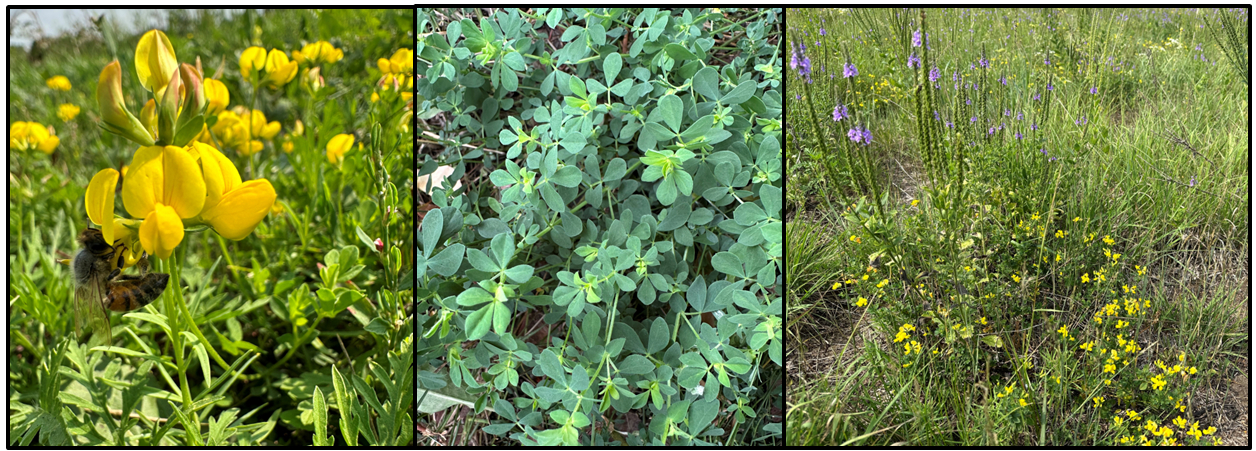
Birdsfoot trefoil is a fairly common legume found in lawns and roadsides. It has been traditionally used as a forage legume. Its yellow flowers can be a source of nectar and pollen for surrounding bees (Figure 4). Leaves at the top of the stalks are made up of five leaflets, unlike white clover (Trifolium repens), which has three. Birdsfoot trefoil leaflets can also be differentiated from white clover with leaflets that can be more oblong and do not have a watermark. This weed is a non-regulated invasive species that becomes aggressive in prairies. Homeowners with properties near prairies should contain or remove it from the lawn, as the seeds can easily travel to nearby areas.
Crownvetch (Securigera varia)

Crownvetch is a legume on the noxious weed list. It can be identified by its light pink flowers and smooth, ovate leaflets (Figure 5). In regularly mown lawns, crownvetch does not flower readily, but will spread by rhizomes. In unmown situations, it aggressively grows over the existing vegetation. It is often found with birdsfoot trefoil in prairies and along roadsides and railways. It is recommended to remove crownvetch, especially if the property is located near a prairie.
Yellow toadflax (Linaria vulgaris)
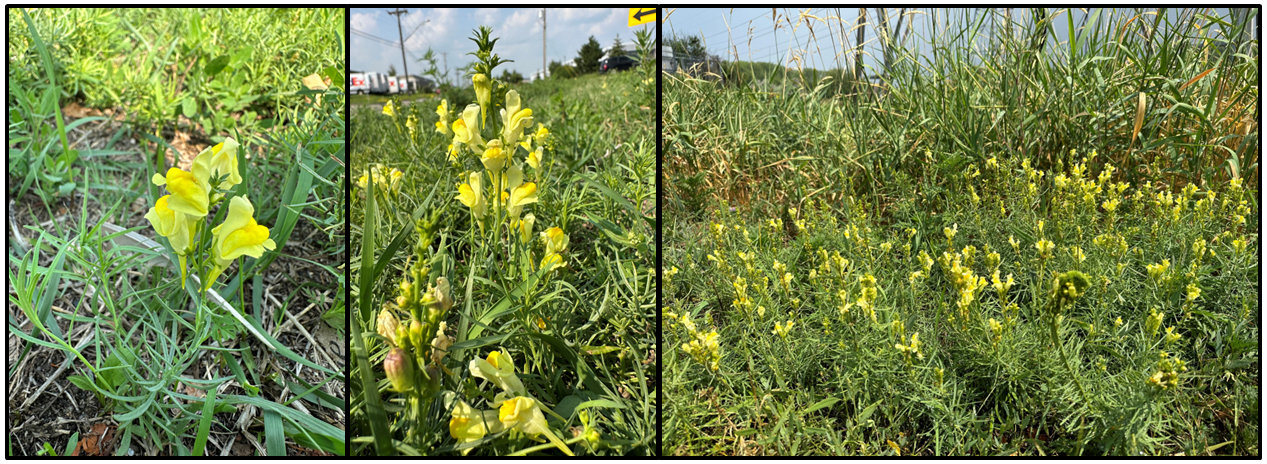
Yellow toadflax is a non-regulated invasive plant species. Its narrow, whorled leaves are usually a pale green or slightly silvery when compared to surrounding plants (Figure 6). Some homeowners may be attracted to its popcorn-like flowers and allow it to grow and bloom in their lawns or garden beds. Another common name for this plant is “butter and eggs,” due to its yellow and gold flowers. Yellow toadflax is often found on roadsides or other disturbed areas. Its rhizomatous spread can outcompete prairie and pasture plants. Homes near prairies and farmland should consider removing yellow toadflax from their properties.
Oxeye daisy (Leucanthemum vulgare)
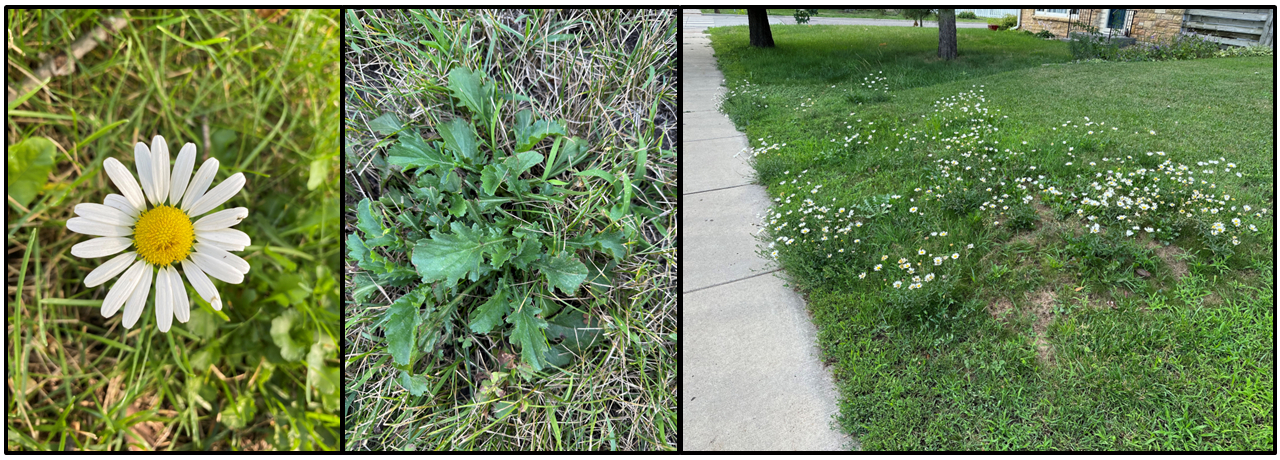
Oxeye daisy is a non-regulated invasive plant species. Its basal leaves are somewhat fleshy and scalloped (Figure 7). White flowers with yellow centers can be seen decorating lawns, gardens, roadsides, and other trafficked areas throughout the state. It is often confused with shasta daisy (Leucanthemum x superbum). Shasta daisy has basal leaves that are not as scalloped as oxeye daisy leaves. Shasta daisy is also not as aggressive, as it has a bunch-type growth habit, whereas oxeye daisy spreads by rhizomes and seed. Oxeye daisy is not very competitive in native prairies; however, it can displace plants in pastures and other open areas or wooded edges. Some homeowners will allow the oxeye daisy to bloom in their lawns and avoid mowing them until they are finished flowering. To reduce its spread by seed, it is recommended to control or mow them, especially when they are beginning to open their flowers.
White/yellow sweetclover (Melilotus officinalis)
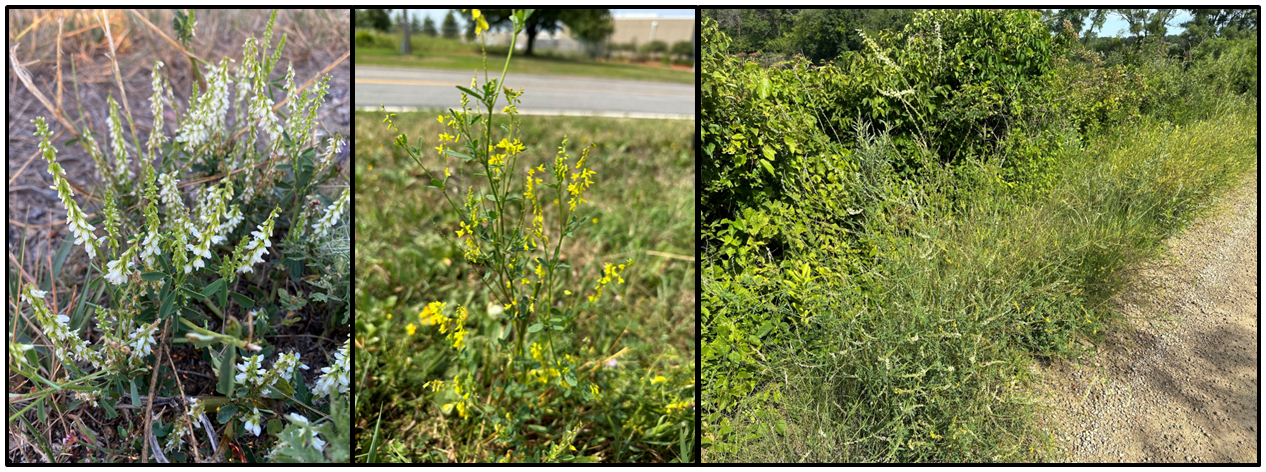
White and yellow sweetclover are leguminous, non-regulated invasive plant species. They can vary in size, from mowing height to the height of a typical refrigerator. Their leaves are made up of three narrow leaflets (Figure 8). Each leaflet has petite, ridged edges, and the middle leaflet tends to have a short petiolule while the petiolules of the other two leaflets can be absent. Upright stalks house small white or yellow flower clusters. These species thrive in sunny locations, spreading by seed that can be dormant for decades. White and yellow sweetclover can crowd out plants in prairies, pastures, and roadsides.
Hoary alyssum (Berteroa incana)

Hoary alyssum is a non-regulated invasive plant species. Its small white flower clusters are often seen in full-sun, dry areas (Figure 9). Leaves and stems have a silvery tint to them due to dense hairs. It has basal leaves that are oblong and smooth with long, upright flowering stalks made up of narrow, sessile leaves. These stalks are often lodged in mown lawns. Hoary alyssum can be invasive in prairies, pastures, and roadsides. Homeowners with this species in their lawn may consider mowing while it is flowering to reduce the seed set, or eliminating if prairies or pastures are nearby.
Taking action to safeguard native or agricultural systems can be carried out by monitoring the lawn and nearby areas. Many of these invasive plant species are either in bloom or going to seed this month, easing identification. Once identified, be aware of the surrounding landscapes, especially those near wooded areas, prairies, pastures, city/county/state parks, and farmland. From there, determine if control or eradication is warranted. Broadleaf control with the use of herbicides is best done in the fall. If this is the course of action, be sure to follow the herbicide label directions of use. Other management practices include mowing to prevent the flower from going to seed, and hand-pulling if feasible. Control of these non-regulated invasive plant species relies on the homeowner or land manager to protect our vulnerable, Minnesota landscapes.
To learn more about invasive plant species, visit the Minnesota Department of Natural Resources invasive species list.